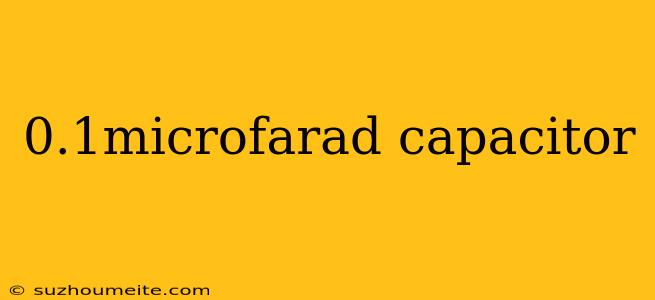0.1 Microfarad Capacitor: Understanding its Applications and Characteristics
Introduction
A 0.1 microfarad (μF) capacitor is a type of electronic component widely used in various electronic circuits. It is a crucial component in many applications, including power supplies, audio equipment, and radio frequency (RF) circuits. In this article, we will delve into the characteristics, applications, and types of 0.1 μF capacitors.
Characteristics of 0.1 μF Capacitors
Capacitance: The capacitance of a 0.1 μF capacitor is its ability to store electric charge. The unit of capacitance is the Farad (F), and 0.1 μF is equivalent to 100,000 picofarads (pF).
Voltage Rating: The voltage rating of a 0.1 μF capacitor determines the maximum voltage it can withstand without breaking down. Common voltage ratings for 0.1 μF capacitors include 50V, 100V, 200V, and 500V.
Tolerance: The tolerance of a 0.1 μF capacitor indicates the acceptable range of capacitance values. A tolerance of ±10% means the actual capacitance can be between 0.09 μF and 0.11 μF.
Equivalent Series Resistance (ESR): ESR measures the internal resistance of a capacitor. A lower ESR value indicates less energy loss and better performance.
Applications of 0.1 μF Capacitors
Power Supply Filtering: 0.1 μF capacitors are often used in power supply filtering circuits to remove ripple voltage and ensure a smooth DC output.
Audio Equipment: In audio equipment, 0.1 μF capacitors are used to filter out high-frequency noise and hum, ensuring clear and distortion-free sound.
RF Circuits: In radio frequency (RF) circuits, 0.1 μF capacitors are used to tune antennas, filters, and resonant circuits.
Coupling and Decoupling: 0.1 μF capacitors can be used as coupling capacitors to transfer AC signals between circuits or as decoupling capacitors to filter out noise and ripple.
Types of 0.1 μF Capacitors
Ceramic Capacitors: Ceramic capacitors are the most common type of 0.1 μF capacitor. They are inexpensive, compact, and offer high reliability.
Film Capacitors: Film capacitors are made of plastic film and offer better stability and accuracy than ceramic capacitors.
Electrolytic Capacitors: Electrolytic capacitors have a higher capacitance density than ceramic or film capacitors but are larger and more expensive.
Surface-Mount (SMD) Capacitors: SMD capacitors are compact and suitable for surface-mount technology (SMT) applications.
Conclusion
In conclusion, 0.1 μF capacitors are versatile components with numerous applications in power supply, audio, and RF circuits. Understanding their characteristics, applications, and types can help engineers and designers make informed decisions when selecting capacitors for their projects.
